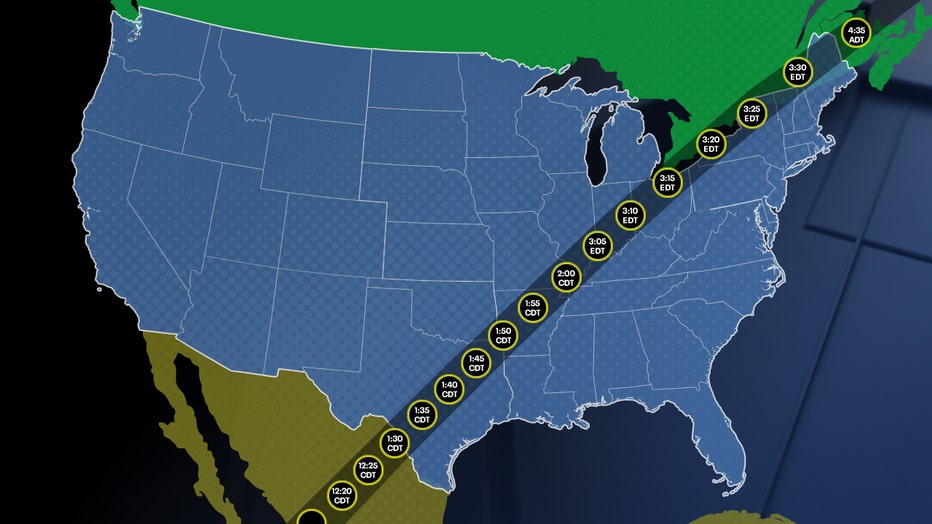How to check your eclipse glasses to make sure they work
Eye protection for April's total solar eclipse
If you’re among the millions of people who will get the chance to witness April’s total solar eclipse, you’re going to want to use eye protection. Vitreoretinal surgeon at New York Eye and Ear Infirmary of Mount Sinai Dr. Avnish Deobhakta joined FOX Weather on Sunday to explain the dangers of viewing the eclipse without proper eye protection.
If you’ve ever experienced or plan to experience a total solar eclipse like the one coming up on April 8, you’ve likely heard it’s not safe to look directly at the sun without proper eye protection.
The only time it’s safe to look directly at the sun is the brief period when the moon completely blocks the sun. Looking at the sun through a camera lens, binoculars, or any other type of lens without a special solar filter will also injure your eyes.
There’s no shortage of eclipse glasses and viewers to choose from (or you can make your own), but how do you know if the eclipse glasses or viewer you bought meets industry safety standards?
RELATED: Total solar eclipse viewer using cereal box: How to build your own
How to make sure your eclipse glasses are safe

The City of Dripping Springs, Texas is preparing for the solar eclipse with a set of larger than life glasses on display at Veterans Memorial Park on March 5, 2024. Millions of people across the United States are preparing to watch Aprils total solar
NASA says before you take your eclipse glasses out to the main event, do the following checks to make sure they’re safe to use.
First, find a bright light – like a lamp or flashlight – then hold your eclipse glasses up to the light and look through them. The light should appear extremely dim or not at all.
RELATED: Eclipses of the past were calamitous, not celebratory
"You should only be able to see the filament of a light bulb, but not the glow surrounding the bulb," NASA says.
If your eclipse glasses have any marks or scratches on them, throw them away.
If you’re using older glasses from a previous eclipse, make sure they haven’t been damaged or scratched.
Glasses considered safe for eclipse-viewing will meet the ISO 12312-2 standard, so look for that label, but organizers of the Solar Eclipse Across America website say they’ve found some glasses that say they’re compliant, but they’re not. The website recommends checking out its page of verified safe eclipse viewers and glasses.
Total solar eclipse path

Projected path and time of totality for the 2024 total solar eclipse over the U.S.
The April 2024 solar eclipse will be visible, at least in part, to nearly everyone in the U.S. But the path of totality – where the moon will completely block the sun – is a 115-mile-wide region that stretches from southern Texas up through Ohio, then over to northern Maine.
Large cities in the path of totality include:
- Austin, Texas
- Dallas, Texas
- Little Rock, Arkansas
- Carbondale, Illinois
- Indianapolis, Indiana
- Cleveland, Ohio
- Buffalo, New York
- Plattsburgh, New York
- Presque Isle, Maine
The farther you are from that path, less and less of the sun will appear to be blocked.
What time is the solar eclipse?
Southern Texas will see the peak of totality first, around 1:30 p.m. Central Daylight Time. Then Dallas at 1:42 p.m., with the time getting later and later as the moon’s shadow moves north. Indianapolis will see the peak around 3:05 p.m. Eastern Daylight Time; Cleveland at 3:15 p.m., and northern Maine around 3:30 p.m.
However, it will take several hours for the moon to move across the sun, so the actual eclipse event will start just over an hour before the peak of totality, with more and more of the sun slowly being blocked.
How long is the solar eclipse?
Again, that depends on where you are. Those closest to the center of the path will see total darkness for about four minutes at the peak of totality.
But because the moon moves slowly across the sun’s path, the entire eclipse event – from when the moon first clips the sun until the time it clears – will last from 90 minutes to over two hours for those in the path of totality.
Where do I look for the solar eclipse?
The easiest way to know may be to step outside in the days leading up to the eclipse and see where the sun is during the afternoon.
MORE: How to get the best view of the solar eclipse
Early afternoon on April 8, the sun will be pretty high in the sky. As always, though, the further north you are, the lower in the sky the sun will appear.
For example, in Austin, the sun will be at 67 degrees up from the horizon at the peak of totality. Remember, 90 degrees is straight up, so 67 degrees is just over two-thirds up into the sky from the horizon.
In Cleveland, meanwhile, the sun will be slightly lower, at only 49 degrees – just over halfway up in the sky.
When is the next total solar eclipse?
After 2024, NASA says, the next total solar eclipse visible from any point in the contiguous United States will occur in 2044. Totality will only be visible from North Dakota and Montana.
The next total solar eclipse that will travel across the lower 48 states from coast to coast is in 2045.

